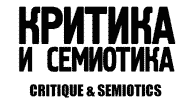Identity of the city: Visual space and cultural sense
DOI: 10.23951/2312-7899-2025-2-8-30
The article shows that urban identity and city identity are fundamentally different concepts: the former describes a person’s position of conscious belonging to a certain urban community, the latter describes the historical equality of the city to itself, its unity in time and space. At the same time, both concepts are open-ended: urban identity is, in principle, conditional and dynamic, and city identity is always greater than its self-identity. The identity of the city to itself turns it into a static museum of self-sufficient artifacts. The identity of the city confirms its status as a dynamic cultural phenomenon, changeable in its constancy and constant (the same) in its variability. The visual space of the city serves as a basis for self-identification only when it is perceived as a sign system – a text that can be read not only at the level of content and meaning, but also at the level of sense. To identify oneself with a specific city means to accept and master the values, ideals, socio-cultural attitudes and moral guidelines of a specific urban community, that is, its senses. Urban identity is based on such penetration into the cultural sense of the city. In turn, city identity largely depends on the urban image that is formed by the city dwellers – the bearers of the urban identity. The genesis of a specific city’s identity is the result of acts of understanding its essence: its history, which takes on the features of a biography; its architectural environment, which takes on the character of a semiotic system; and its spatial structure, which acquires the properties of a text. In this perspective, the city’s visual environment is always “larger” than its material or aesthetic dimensions and acts as a form of representation of meanings that equally underlie both urban identity and city identity.
Keywords: visual semiotics, urban studies, city, identity, visual space, cultural sense
References:
Abashev, V. V. (2000). Perm as a Text. Perm in Russian Culture and Literature of the 20th Century. Izdatel’stvo Permskogo universiteta. (In Russian).
Alzemeneva, E. V., & Mamaeva, Yu. V. (2021). Identity of the Urban Environment. Engineering and Construction Bulletin of the Caspian Region, 2(36), 40–47. (In Russian).
Antsiferov, N. P. (1922). The Soul of Petersburg. Brokgaus & Efron. (In Russian).
Assmann, J. (2004). Das kulturelle Gedächtnis. Schrift, Erinnerung und politische Identität in frühen Hochkulturen (M. Sokolskaya, Trans.). Yazyki slavyanskoy kul’tury.
Avanesov, S. S. (2024). City as a Cultural Project: Principia of Humanitarian Urban Studies. Indrik. (In Russian).
Avanesov, S. S., & Fedotova, N. G. (2022). City: In Search of Identity. Aleteya. (In Russian).
Baudrillard, J. (1997). La ville et la haine (B. Narumov, Trans.). Logos, 9, 107–116.
Chernyavskaya, O. S. (2011). Interpretation of the Concept Territorial Identity. Herald of Vyatka Humanitarian State University, 4(4), 70–76. (In Russian).
Darenskiy, V. (2015). The City as “Natural” and Nature as “Artificial” in the Existence of Contemporary Man. International Journal of Cultural Research, 1(18), 24–35. (In Russian).
Fedotova, N. G. (2024). Orthodox Images in the Urban Imaginary of Veliky Novgorod. Journal of Visual Theology, 6(2), 368–381. (In Russian).
Filin, V. A. (2006). Visual Environment of the City. Herald of the International Academy of Sciences (Russian Section), 2, 43–50. (In Russian).
Gornova, G. V. (2019). Urban Identity: Philosophical and Anthropological Foundations. Amfora. (In Russian).
Grishkovets, E. (2008). The Year of Ljife. AST. (In Russian).
Lotman, Yu. M. (2010). Semiosphere. Iskusstvo-SPB. (In Russian).
Sherstiuk, A. A. (2023). Visual-Semiotic Patterns in the Study of Urban Architectural Identity: Artistic and Aesthetic Perception of Old Building Facades in Kaliningrad. Urbis et Orbis. Microhistory and Semiotics of the City, 3(1), 134–148.
Shilekhina, M. S. (2017). Cultural space of the city as its identification person: essence and formation. Bulletin of the Moscow State University of Culture and Arts, 3(77), 52–62. (In Russian).
Speshilova, E. I. (2023). The Imaginary in Urban Studies. ΠΡΑΞΗΜΑ (Praxema). Journal of Visual Semiotics, 4(38), 59–78. (In Russian).
Telia, V. N. (1996). Russian Phraseology. Semantic, Pragmatic and Linguocultural Aspects. Yazyki russkoy kul’tury. (In Russian).
Tonev, L. (1973). Composition of a Modern City (N. Mateev, Trans.). Bolgarskaya academiya nauk.
Zadorin, I. V., Evstifeev, R. V., Krupkin, P. L., Lebedev, S. D., & Shubina, L. V. (2016). Urban Local Identities as a Basis for the Formation of Sustainable Local Communities. A Study of Citywide Identities of Residents of Vladimir, Smolensk, Yaroslavl. ADAPT. (In Russian).
Zamyatin, D. N. (2006). Culture and Space. Modeling of Geographical Images. Znak. (In Russian).
Issue: 2, 2025
Series of issue: Issue 2
Rubric: ARTICLES
Pages: 8 — 30
Downloads: 853










